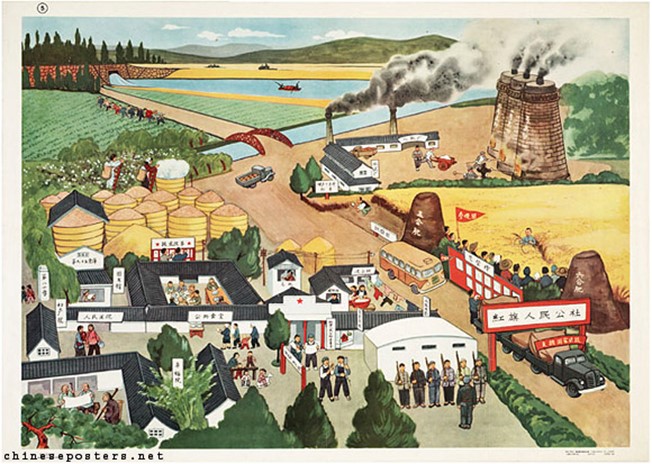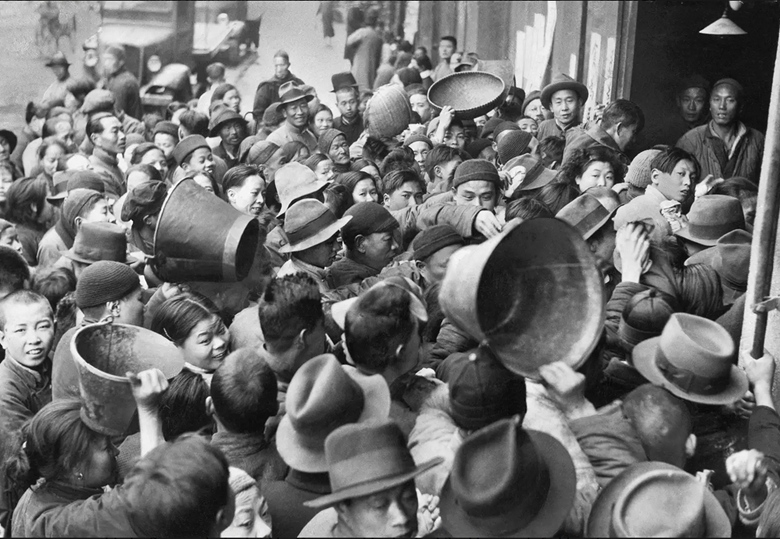

Table of Contents
Introduction
Throughout history, famine and other similar disasters plagued humankind. Those were usually caused by natural forces beyond human control. Yet, the 20th century proved that nature was never able to match human errors in its destructibility and fatality. Disregarding the intentional killing and destruction of modern warfare, the most disastrous event of that century was the famine caused by the Great Leap Forward (GLF) campaign in China. It was unintentional, a perfect storm of errors and stubbornness, faulty reasoning, and reliance on ideology rather than factuality. What exactly happened and how bad it actually was?
Origins of the campaign
Chinese development up to 1958
The Chinese Communist Party (CCP) took over control of China in 1949, immediately beginning the transformation of Chinese society. The goal of the new government was twofold. The most vital was economic development, which was almost nonexistent, torn by World War II and decades of factual anarchy in China before it. The second was, of course, the creation of a socialist and communist society, based on the ideals of the Leninist-Marxist ideology. Thus, in the early years of its reign, the CCP created several campaigns that started such a transformation. On the economic front, they began gradual collectivization, first introducing “mutual aid teams” then slightly larger agricultural cooperatives, as well as land redistribution through the agrarian reform. Furthermore, the party began investing in the almost unfunctional industry. All of these changes were following the steps of the USSR, including the First Year Plan (FYP) for 1953-1957, which outlined industrialization based on the Soviet model.
On the ideological front, they formed several campaigns which were aimed at “re-educating” intellectual and bourgeoisie elites. These proved to be rather violent, as the CCP began dealing with any possible opposition. Cleansing the society from “elements of capitalist obstructions” naturally caused a lot of friction, as the party also lost support from highly needed educated and professional elites. In an attempt to remedy the relations, in 1956 the CCP created the so-called The Hundred Flowers Campaign, encouraging people to openly voice their opinions of the regime. It quickly backfired, as too many voices were critical, prompting Mao Zedong to enact The Anti-Rightist Campaign in 1957, cracking down on critics, freedom of expression, and thought.
Sino-Soviet relations and the leap
The initial reforms provided some positive results, as the Chinese economy began a slow and steady growth. Initially satisfied with any kind of improvement, Mao quickly became somewhat impatient. The need for quicker development was twofold. On one hand, the initial socialist zeal and fervor of the masses were toning down, as people became more concerned with the realities of life rather than expectations. Though that was to be expected as the nation returned to some sense of normality, Mao felt it was partially due to unfulfilled expectations of the initial grand promises of the party. However, more than the lacking enthusiasm of the masses, Mao needed to speed up the economic growth because of his foreign policies.

Chinese leader Mao Zedong with Soviet leader Nikita Khrushchev in August 1958. Source
Since Khrushchev’s denunciation of Stalin, Sino-Soviet relations began to sour. Mao wasn’t pleased with the new Soviet policy, especially because he wasn’t notified. Furthermore, destalinization attacked the idea of personality cult, something that Mao was building around himself. Thus, Mao felt there was a need to strengthen China, partially through the economy, making it more self-reliant. Only then he and China could challenge the USSR for leadership over the socialist bloc, something Mao desired. With such issues on his mind, Mao began to search for a way around it. A solution was found in a new campaign that not only aimed to speedily develop the Chinese economy, but also further revolutionize its society. As a cherry on top, it would also show the rest of the socialist world that not only the Soviet model wasn’t sacred but that it could be outdone. He dubbed it the Great Leap Forward, symbolizing his high goals and hopes for the campaign.
Ideas and ideology of the Great Leap Forward
Economic ideas of the campaign
Though the GLF is often represented as a radical departure from the ideas of the FYP, it was actually radically building upon it. The main goal was still quick development of industry, most notably heavy industry in the realm of steel production. However, parts of the Chinese leadership, including Mao, realized that when the USSR was going through the same steps, they had both a more developed industrial base as well as better agricultural output. That allowed them to export grain for investments in the industry. Thus, they concluded that the only proper way for China to evolve was to simultaneously develop both agriculture and industry. This was encapsulated by the phrase “walking on both legs”.
More specifically, agriculture was to be developed by large irrigation projects and land clearing. Essentially, expanding the area of farmable land. These ventures were to be done without any major state funding, relying on the mobilization and zeal of the masses. The same enthusiasm was to be harnessed in industry, but with added funding. The state was to acquire needed machinery and equipment, allowing for modern industrial production. At the same time, they promoted ideas of “backyard furnaces”, producing steel in the traditional methods that needed no governmental investment, mere will of the working class to engage in such production. Thus on paper, the GLF was supposed to increase the production and economy of China on all fronts.
Social and ideological reforms
On a broader and less defined ideological specter, Mao decided that the GLF should be primarily based on zeal and enthusiasm of the masses, contrary to previous reliance on experts and technical norms. In his viewpoint, it was such a revolutionary elan that carried the party through the civil war and Japanese occupation. Thus, as Mao began to feel the relaxation of communist fervor, he thought that rekindling it would bring only additional wind to the campaign, while simultaneously consolidating the CCP rule.
More radical reform came in the appearance of people’s communes, large socio-administrative units comprising anywhere between 5,000 and 20,000 households. On the administrative side, they simply assumed roles of townships – educational and medicinal services, policing, tax collection, etc. However, the major break was on the social side, as the communes were supposed to be the final step towards collectivism and functional communism. Private ownership was practically abolished, as everything became communal, with everyone contributing to the work done. Similarly, everyone was paid equally, regardless of how much and what kind of work they did. Communal kitchens, children’s care, and even washing of clothes became the norm. Such practices were not only supposed to be a leap towards actual communism but also improve the productivity of its members, as they supposedly had fewer household chores and issues distracting them from their actual work.

A Chinese school poster showing the ideal people’s commune - with a rich harvest, backyard furnaces, communal facilities, and the people’s militia. Source
Leaping into a chasm
Chaos across China
Despite having all the best intentions, the GLF was a blunder on such a large scale that it managed to disrupt the entire nation. The first major issue came in the form of false reporting of lower party cadres. These officials and the masses around them constantly reported higher yields, more cleared lands, more steel produced. The upper echelons just gobbled those up as it was reaffirming their actions. This was partly because some of them were caught up in the fervor of the campaign, but also because The Anti-Rightist Campaign taught them not to criticize. Such fears were only heightened when Mao made an example of Peng Dehuai, his defense minister and old comrade and close associate. In mid-1959 Peng privately criticized Mao, who published his letter and purged him from all government and party positions.
Thus, the opposition in the party was forcibly silenced, but the people began revolting as their lives turned into complete disarray. Their habits were turned upside-down by the communes. The familial core was disrupted, local markets defunct, the working load increased due to unrealistic quotas. The system became tortuous than ever before, as the cadres began working the masses to death. People rebelled in certain areas, forcibly stifled. Instead of a new communist utopia, China received only chaos.
Ultimate failure – the great famine
Social unrest may have been troubling, but it could be dealt with. However, the biggest blunder of the GLF was the famine it produced. As the local official reported high yields, the central government was more than pleased to continue its high food taxation, as a source for investment in the industry. The lower cadres said nothing as their communes were giving most of their gains, leaving them without food for themselves. Thus, they began plunging into starvation while China was exporting its grain. Aiding to that was the fact that from 1959 to 1961 China had problems with droughts and locusts. To make matters worse, as the higher party echelons got wind of famine, they decided to continue their export and reject any foreign aid. Mao and his clique refused to admit failure while people began to die in millions across China.

A crowd of citizens push toward government station selling rice very cheap. Source
Adding to the problem was the fact that the industry wasn’t developing in any significant manner. Most of the backyard furnace production was of poor often unusable quality, while overall industrial production rose insignificantly while putting extreme stress on the workers and the equipment as both were overworked by the zealous leadership. In the end, the GLF only managed to disrupt and starve a nation, without making any noteworthy progress.
Epilogue
Mao and his clique initially clung to the ideas of the GLF, defending the shortcomings any way they could, but by late 1961 and early 1962 the experiment was over. For a short while, the party and China laid in the hands of the moderate and grounded cadres centered around Liu Shaoqi and Deng Xiaoping. Nevertheless, by then anywhere between 20 and 55 million people died, mostly from starvation, but also from political violence and oppression. That makes the GLF probably the second deadliest event in the 20th century after World War II. Furthermore, the overall Chinese economy crumbled under the pressure of failing agriculture, falling below the 1958 mark in the early 1960s. It also challenged Mao’s supremacy over China, as he remained in the backseat until he returned to prominence with the Cultural Revolution (1966-1976).
The GLF also marked the starting point of open deterioration of Sino-Soviet relations, as the Chinese government began its more open attack on the Soviets and their system. Soviets responded similarly, despite initially having at least ambivalent public opinion for the campaign. They even warned their Chinese comrades of the dangers of such campaigns, as they tried them in the early 1930s and failed. In the end, the Soviets withdrew their technical and economic support, as they felt increasingly attacked by the Chinese, further adding to the failing Chinese economy. Of course, that only gave at last partial excuse to the CCP, blaming the USSR withdrawal of technicians for some GLF failings. Furthermore, losing other socialist allies with the Soviets and without having the strength to gain any other, China remained isolated for a while.
In the end, the GLF was a perfect storm of incompetence, overzealousness, fear, faulty ideology, and stubbornness. Its misfortunes were only expanded by natural disasters. Finally, the system failed because it was rigid, based on unproven theories and ideas, without much regard for reality and functionality.
Online sources
Further reading
-
Jonathan D. Spence, The Search for Modern China, W. W. Norton & Company, 1990.
-
J. K. Fairbank and M. Goldman, China – A new history, Harvard University Press, 2006.
-
R. MacFarquhar and J. F. Fairbank, The Cambridge history of China Vol. 14, part I, Cambridge University Press, 1987.
-
K. E. Manning and F. Wemheuer, Eating bitterness: new perspectives on China’s great leap forward and famine, UBC Press, 2011.
-
W. Li and D. T. Yang, The Great Leap Forward: Anatomy of a Central Planning Disaster, Journal of Political Economy, Vol. 113, No. 4 (August 2005), pp. 840-877.
-
Yang Jisheng (2010): The Fatal Politics of the PRC’s Great Leap Famine: the preface to Tombstone, Journal of Contemporary China, 19:66, pp. 755-776.
-
X. Meng, N. Qian, and P. Yared, The institutional causes of china’s great famine, 1959-1961, Review of Economic Studies, Vol. 82, Issue 4, 2010, pp. 1568-1611.
-
R. MacFarquhar, The Origins of The Cultural Revolution: Vol. 2 The Great Leap Forward 1958-1960, Columbia University Press, 1983.
-
Z. Shen and Y. Xia, The Great Leap Forward, the People’s Commune and the Sino-Soviet Split, Journal of Contemporary China (2011), 20(72), November, pp. 861–880.
-
Zhou Xun, The great famine in China, 1958– 1962: a documentary history,Yale University Press, 2012.
-
D. T. Yang, China’s Agricultural Crisis and Famine of 1959–1961: A Survey and Comparison to Soviet Famines, Comparative Economic Studies, 2008, 50, pp. 1–29.
-
David Bachman, Bureaucracy, economy, and leadership in China: the institutional origins of the great leap forward, Cambridge University Press, 1991.
-
A. L. Chan, Mao’s crusade: Politics and policy implementation in China’s Great leap forward, Oxford University Press, 2001.
-
F. Dikӧtter, Mao’s great famine: The history of China’s most devastating catastrophe 1958-1962, Walker & Co., 2010.
-
Yang Jisheng, Tombstone – The great Chinese famine 1958 – 1962, Straus and Giroux, 2008.
-
Stuart Scharm, The thought of Mao Tse-tung, Cambridge University Press, 1989.
